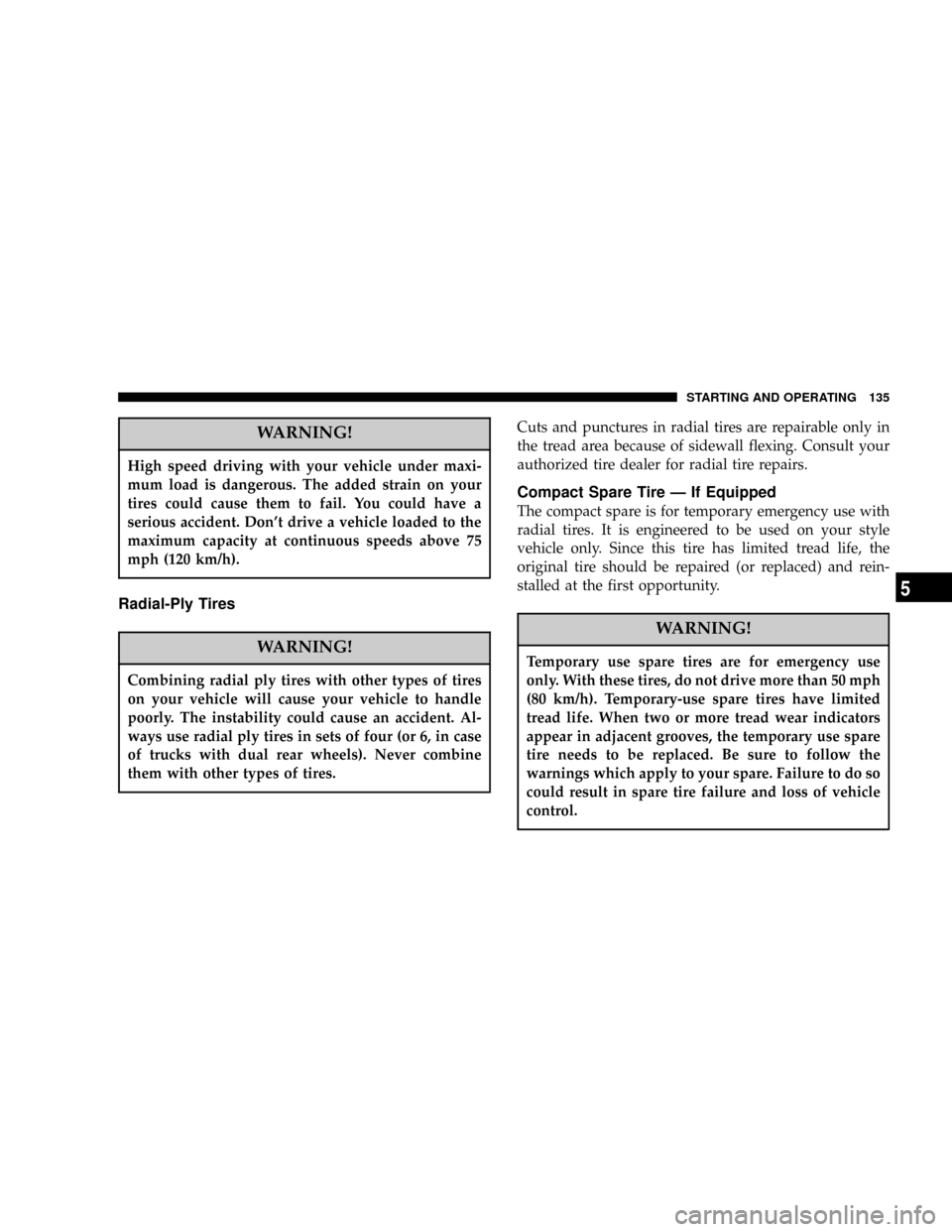2005 DODGE NEON load capacity
[x] Cancel search: load capacityPage 129 of 246

Loading
The vehicle maximum load on the tire must not exceed
the load carrying capacity of the tire on your vehicle. You
will not exceed the tire's load carrying capacity if you
adhere to the loading conditions, tire size and cold tire
inflation pressures specified on the Tire and Loading
Information placard and the Vehicle Loading section of
this manual.
NOTE:Under a maximum loaded vehicle condition,
gross axle weight ratings (GAWR's) for the front and rear
axles must not be exceeded. For further information on
GAWR's, vehicle loading and trailer towing, see the
Vehicle Loading section of this manual.
To determine the maximum loading conditions of your
vehicle, locate the statement ªThe combined weight of
occupants and cargo should never exceed XXX kg or XXX
lbs.º on the Tire and Loading Information placard. The
combined weight of occupants, cargo/luggage and
trailer tongue weight (if applicable) should never exceed
the weight referenced here.
Steps for Determining Correct Load Limit
1. Locate the statement ªThe combined weight of occu-
pants and cargo should never exceed XXX poundsº on
your vehicle's placard.
2. Determine the combined weight of the driver and
passengers that will be riding in your vehicle.
3. Subtract the combined weight of the driver and pas-
sengers from XXX kilograms or XXX pounds.
4. The resulting figure equals the available amount of
cargo and luggage load capacity. For example, if ªXXXº
amount equals 1400 lbs. and there will be five 150 lb.
passengers in your vehicle, the amount of available cargo
and luggage load capacity is 650 lb. (since 5 x 150 = 750,
and 1400 ± 750 = 650 lb.)
5. Determine the combined weight of luggage and cargo
being loaded on the vehicle. That weight may not safely
exceed the available cargo and luggage load capacity
calculated in step 4.
STARTING AND OPERATING 129
5
Page 130 of 246

6. If your vehicle will be towing a trailer, load from your
trailer will be transferred to your vehicle. Consult this
manual to determine how this reduces the available
cargo and luggage load capacity of your vehicle.
NOTE:The following table shows examples on how to
calculate total load, cargo/luggage and towing capacities
of your vehicle with varying seating configurations andnumber and size of occupants. This table is for illustra-
tion purposes only and may not be accurate for the
seating and load carry capacity of your vehicle.
NOTE:For the following example the combined weight
of occupants and cargo should never exceed 865 lbs. (392
Kg).
130 STARTING AND OPERATING
Page 132 of 246

WARNING!
Overloading of your tires is dangerous. Overloading
can cause tire failure, affect vehicle handling, and
increase your stopping distance. Use tires of the
recommended load capacity for your vehicle. Never
overload them.
TIRESÐGENERAL INFORMATION
Tire Pressure
Proper tire inflation pressure is essential to the safe and
satisfactory operation of your vehicle. Three primary
areas are affected by improper tire pressure:
1. SafetyÐ
WARNING!
Improperly inflated tires are dangerous and can
cause accidents.
²Under inflation increases tire flexing and can
result in tire failure.
²Over inflation reduces a tire's ability to cushion
shock. Objects on the road and chuck holes can cause
damage that results in tire failure.
²Unequal tire pressures can cause steering prob-
lems. You could lose control of your vehicle.
²Over inflated or under inflated tires can affect
vehicle handling and can fail suddenly, resulting in
loss of vehicle control.
²Unequal tire pressures from one side of the vehicle
to the other can cause the vehicle to drift to the right
or left.
Always drive with each tire inflated to the recom-
mended cold tire inflation pressure.
132 STARTING AND OPERATING
Page 135 of 246

WARNING!
High speed driving with your vehicle under maxi-
mum load is dangerous. The added strain on your
tires could cause them to fail. You could have a
serious accident. Don't drive a vehicle loaded to the
maximum capacity at continuous speeds above 75
mph (120 km/h).
Radial-Ply Tires
WARNING!
Combining radial ply tires with other types of tires
on your vehicle will cause your vehicle to handle
poorly. The instability could cause an accident. Al-
ways use radial ply tires in sets of four (or 6, in case
of trucks with dual rear wheels). Never combine
them with other types of tires.
Cuts and punctures in radial tires are repairable only in
the tread area because of sidewall flexing. Consult your
authorized tire dealer for radial tire repairs.
Compact Spare Tire Ð If Equipped
The compact spare is for temporary emergency use with
radial tires. It is engineered to be used on your style
vehicle only. Since this tire has limited tread life, the
original tire should be repaired (or replaced) and rein-
stalled at the first opportunity.
WARNING!
Temporary use spare tires are for emergency use
only. With these tires, do not drive more than 50 mph
(80 km/h). Temporary-use spare tires have limited
tread life. When two or more tread wear indicators
appear in adjacent grooves, the temporary use spare
tire needs to be replaced. Be sure to follow the
warnings which apply to your spare. Failure to do so
could result in spare tire failure and loss of vehicle
control.
STARTING AND OPERATING 135
5
Page 138 of 246

Replacement Tires
The tires on your new vehicle provide a balance of many
characteristics. They should be inspected regularly for
wear and correct cold tire inflation pressure. The manu-
facturer strongly recommends that you use tires equiva-
lent to the originals in size, quality and performance
when replacement is needed (see the paragraph on tread
wear indicators). Refer to the Tire and Loading Informa-
tion placard for the size designation of your tire. The
service description and load identification will be found
on the original equipment tire. Failure to use equivalent
replacement tires may adversely affect the safety, han-
dling, and ride of your vehicle. We recommend that you
contact your original equipment or an authorized tire
dealer with any questions you may have on tire specifi-
cations or capability.WARNING!
²Do not use a tire, wheel size or rating other than
that specified for your vehicle. Some combina-
tions of unapproved tires and wheels may change
suspension dimensions and performance charac-
teristics, resulting in changes to steering, han-
dling, and braking of your vehicle. This can cause
unpredictable handling and stress to steering and
suspension components. You could lose control
and have an accident resulting in serious injury or
death. Use only the tire and wheel sizes with load
ratings approved for your vehicle.
²Never use a tire with a smaller load index or
capacity, other than what was originally equipped
on your vehicle. Using a tire with a smaller load
index could result in tire overloading and failure.
You could lose control and have an accident.
²Failure to equip your vehicle with tires having
adequate speed capability can result in sudden
tire failure and loss of vehicle control.
138 STARTING AND OPERATING
Page 146 of 246

WARNING!
A fire may result if gasoline is pumped into a
portable container that is inside of a vehicle. You
could be burned. Always place gas containers on the
ground while filling.
VEHICLE LOADING
Vehicle Loading Capacities
Front Seat Occupants....................... 2
Rear Seat Occupants........................ 3
Luggage....................... 115lbs. (52 kg)
Rated Vehicle Capacity............ 865lbs. (392 kg)
TRAILER TOWING
In this section you will find safety tips and information
on limits to the type of towing you can reasonably do
with your vehicle. Before towing a trailer carefully re-
view this information to tow your load as efficiently and
safely as possible.
Perform maintenance services as prescribed in the main-
tenance schedules manual. When your vehicle is used for
trailer towing, never exceed the gross axle weight rating
(GAWR) by the addition of:
²The tongue weight of the trailer.
²The weight of any other type of cargo or equipment
put in or on your vehicle.
²Remember that everything put in or on the trailer adds
to the load on your vehicle.
146 STARTING AND OPERATING
Page 241 of 246

Odometer
Trip ................................ 80
Oil, Engine.........................169,202
Capacity............................ 202
Change Interval...................... 170
Checking........................... 169
Disposal............................ 172
Filter.............................. 173
Identification Logo.................... 172
Materials Added to.................... 172
Quality............................. 172
Recommendation..................171,202
Synthetic........................... 172
Viscosity............................ 172
Oil Pressure Light....................... 78
Onboard Diagnostic System............166,167
Operator Manuals (Owner's Manuals)......... 4
Outside Air Intake...................103,109
Outside Rearview Mirrors................. 54
Overdrive............................ 118
Overheating, Engine..................... 150
Owner's Manual......................4,229Paint Care............................ 191
Panic Alarm........................... 20
Parking Brake......................... 121
Passing Light........................... 62
Pets.................................. 45
Phone, Cellular........................ 101
Placard, Tire and Loading Information....... 128
Power
Door Locks.......................... 15
Steering.........................124,178
Steering, Checking.................... 178
Sunroof............................. 68
Windows............................ 23
Power Steering Fluid.................... 203
Pregnant Women and Seat Belts............. 30
Preparation for Jacking................... 152
Programming Transmitters................. 20
Radial Ply Tires........................ 135
Radio Broadcast Signals................... 82
Radio Operation......................83,88
Radio, Satellite.......................... 93
Radio (Sound Systems)...............82,83,88
INDEX 241
10
Page 244 of 246

Load Capacity....................128,129
Quality Grading...................... 231
Radial............................. 135
Replacement......................... 138
Rotation............................ 141
Safety...........................124,132
Sizes............................... 125
Snow Tires.......................... 140
Spinning............................ 137
Tread Wear Indicators.................. 137
Towing
Disabled Vehicle...................... 160
Guide.............................. 147
Recreational......................... 148
Weight............................. 147
Trailer Towing......................... 146
Minimum Requirements................ 147
Trailer and Tongue Weight.............. 147
Warnings........................... 146
Trailer Towing Guide.................... 147
Trailer Weight......................... 147
Transaxle
Automatic................. 9,114,116,117,188Manual...................10,67,114,119,190
Overdrive........................... 118
Selection of Lubricant.................. 188
Transmitter Battery Service................ 21
Transporting Pets........................ 45
Tread Wear Indicators................... 137
Trip Odometer.......................... 80
Trip Odometer Reset Button................ 80
Trunk Release Button..................... 18
Trunk Release, Emergency................. 18
Trunk Release Remote Control.............. 18
Turn Signals.........................62,78
Underhood Fuses....................... 195
Uniform Tire Quality Grades.............. 231
Untwisting Procedure, Seat Belt............. 29
Vacuum/Vapor Harnesses................ 185
Variance, Compass....................... 53
Vehicle Identification Number............... 6
Vehicle Loading.....................129,146
Vehicle Modifications/Alterations............ 6
Vehicle Storage......................... 198
244 INDEX